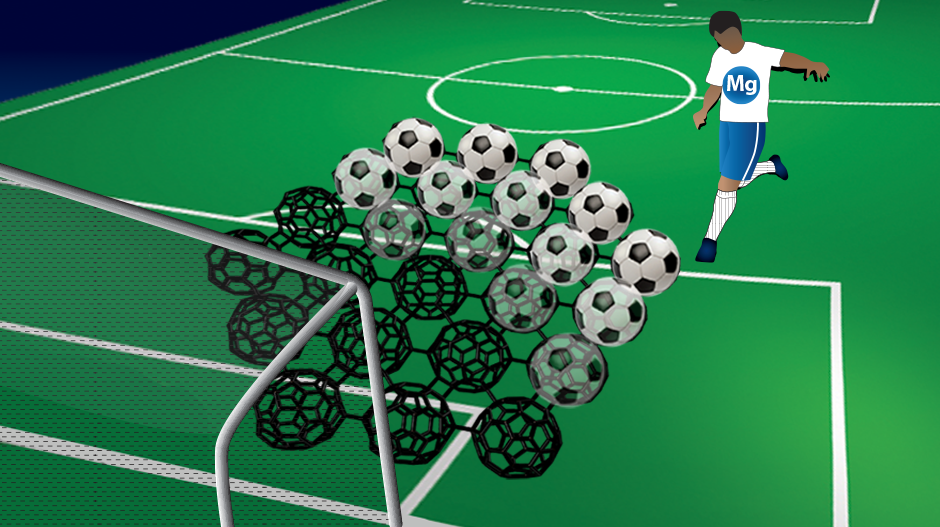Columbia Chemists Discover a New Form of Carbon: Graphene’s “Superatomic” Cousin
Graphullerene, an atom-thin material made of linked fullerene subunits, gives scientists a new form of modular carbon to play with.
 Carbon in its myriad forms has long captivated the scientific community. Besides being the primary component of all organic life on earth, material forms of carbon have earned their fair share of breakthroughs. In 1996, the Nobel Prize in Chemistry went to the discoverers of fullerene, a superatomic symmetrical structure of 60 carbon atoms shaped like a soccer ball; in 2010, researchers working with an ultra-strong, atom-thin version of carbon, known as graphene, won the Nobel Prize in Physics.
Carbon in its myriad forms has long captivated the scientific community. Besides being the primary component of all organic life on earth, material forms of carbon have earned their fair share of breakthroughs. In 1996, the Nobel Prize in Chemistry went to the discoverers of fullerene, a superatomic symmetrical structure of 60 carbon atoms shaped like a soccer ball; in 2010, researchers working with an ultra-strong, atom-thin version of carbon, known as graphene, won the Nobel Prize in Physics.
Today in work published in Nature, researchers led by Columbia chemists Xavier Roy, Colin Nuckolls, and Michael Steigerwald with postdoc and first author Elena Meirzadeh have discovered a new version of carbon that sits somewhere in between fullerene and graphene: graphullerene. It’s a new two-dimensional form of carbon made up of layers of linked fullerenes peeled into ultrathin flakes from a larger graphullerite crystal—just like how graphene is peeled from crystals of graphite (the same material found in pencils).
“It is amazing to find a new form of carbon,” said Nuckolls. “It also makes you realize that there is a whole family of materials that can be made in a similar way that will have new and unusual properties as a consequence of the information written into the superatomic building blocks.”
What is a superatom?
Superatoms, a focus of Columbia’s National Science Foundation-funded Materials Science and Engineering Research Center, are clusters of collectively behaving atoms larger than a molecule but smaller than a crystal. Superatoms can serve as building blocks for all kinds of new materials. Read more
Meirzadeh, who synthesized the first crystals of graphullerite, referred to graphullerene as the superatomic “cousin” of graphene. Unlike graphene and most other two-dimensional materials that are made of repeating elements that are limited to specific bonding geometries and have specific properties as a result, graphullerene’s superatomic structure makes it incredibly modular, she explained. With 60 carbon atoms in the ball to work with, fullerenes can theoretically be linked together in a number of different ways, each of which could yield different electronic, magnetic, and optical properties—this first version represents just one possible configuration, Roy said.
It’s a new way of thinking about structures and their properties as they grow, added Steigerwald. “For more than 30 years, researchers have had the notion that clusters of atoms will behave differently than the larger solids that they form,” he said. “Here, we are making a solid out of an existing carbon superatom to see how that kind of organization will influence its properties. Would the new material behave like fullerene, or like something else?”
The team set out to bond fullerenes molecules rather than individual carbon atoms into a layered, peelable crystal, in order to study its superatomic properties in two dimensions. Meirzadeh used a high-temperature solid-state synthesis technique involving a magnesium scaffold that was later removed—a process involving acid that, after a year spent working with air-sensitive crystals inside a glovebox, was a slightly nerve-wracking final step. “As chemists, we try things and don’t always know what will happen. I thought it would fall apart, but it remained intact,” she recalled. “Seeing an intact, pure carbon crystal that we could then easily exfoliate and study was a great surprise.”
Once the new material was made, Meirzadeh sent samples off to collaborators at Columbia and beyond for initial imaging and characterization. The battery of tests revealed a number of intriguing electrical, optical, and thermal properties. Like graphene, graphullerene can confine and polarize light, it can accept lots of extra electrons, and it can form tunable superlattice structures; these properties make it a promising material with potential applications in new kinds of optical and electronic devices. Compared to fullerenes, graphullerite crystals are shown to have a much higher thermal conductivity, a result of the strong covalent bonds within each graphullerene sheet. Thermal conductivity helps dissipate heat, an important consideration when building devices.
The work is a starting point for the team to explore the potential of graphullerene. From a chemistry perspective, they plan to tweak and tune its modular properties and introduce new structures, while collaborators will look more closely at what happens when graphullerene sheets are combined with different kinds of two-dimensional materials studied at Columbia to see what other secrets carbon conceals.
“The discoveries of both graphene and fullerenes were incredibly impactful,” said Roy. Fullerenes, for example, are used to build organic photovoltaic cells and in medicine as contrast agents for MRI and X-ray imaging and to deliver drug therapies. The more recently discovered graphene, an extremely light yet strong material with numerous unique properties, is being actively explored for potential uses in electronics, energy applications, and more. “Now we’ve combined them together into this new form of carbon. We don’t know exactly what will come out of this work, but it will be very exciting to explore,” he said.
Publication: Elena Meirzadeh, et al., A few-layer covalent network of fullerenes, Nature (2023). DOI: 10.1038/s41586-022-05401-w.
Original Story Source: Columbia University, New York

 Alerts Sign-up
Alerts Sign-up